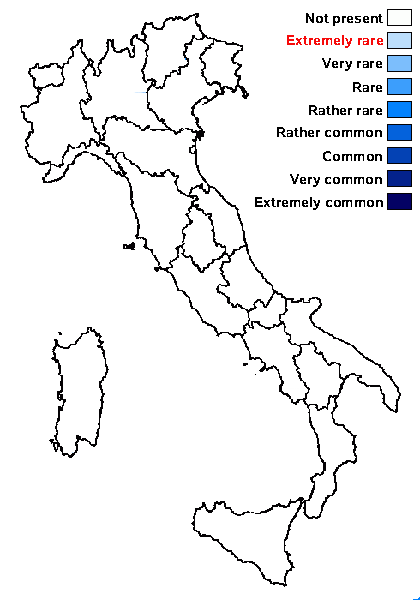Arthonia faginea Müll. Arg.
Flora, 68, 28: 511, 1885
Synonyms: Allarthonia faginea (Müll. Arg.) Redinger
Distribution:
Description: Thallus crustose, lichenized, mostly endosubstratic or very thinly episubstratic, 80-100 µm thick, smooth, pale greenish grey to pale olive-brown, somehow glossy, forming 1-3 cm wide patches, without a dark prothallus. Apothecia arthonioid, more or less immersed in the thallus, flat or slightly convex, variable in shape, round or angular, 0.5-1.3 mm across, black, epruinose, without a distinct proper margin. Epithecium brown, K-, c. 10 µm high; hymenium yellowish brown, c. 100 µm high, hemiamyloid; paraphysoids 1-2 µm thick, the apical cells only slightly wider, brown-walled, often with dark caps; hypothecium pale brown, 60-80 µm high, I+ blue. Asci 8-spored, broadly pyriform, semi-fissitunicate, with a large apical dome and a distinct ocular chamber, Arthonia-type. Ascospores 2-septate, hyaline, oblong-ovoid, slightly broader at one end, the terminal cell often almost as long as the other two cells, 15-18 x 5-6 µm. Photobiont chlorococcoid, the cells 12-14 µm wide. Spot tests: K-, C-, KC-, P-. Chemistry: without lichen substances.Note: a very rare, poorly known species with a few records in Switzerland and Austria, mainly growing in humid beech forests. To be looked for in Italy.
Growth form: Crustose
Substrata: bark
Photobiont: green algae other than Trentepohlia
Reproductive strategy: mainly sexual
Most common in areas with a humid-warm climate (e.g. most of Tyrrenian Italy)
Poorly known taxon in need of further study

Predictive model
Growth form: Crustose
Substrata: bark
Photobiont: green algae other than Trentepohlia
Reproductive strategy: mainly sexual
Most common in areas with a humid-warm climate (e.g. most of Tyrrenian Italy)
Poorly known taxon in need of further study

Predictive model


